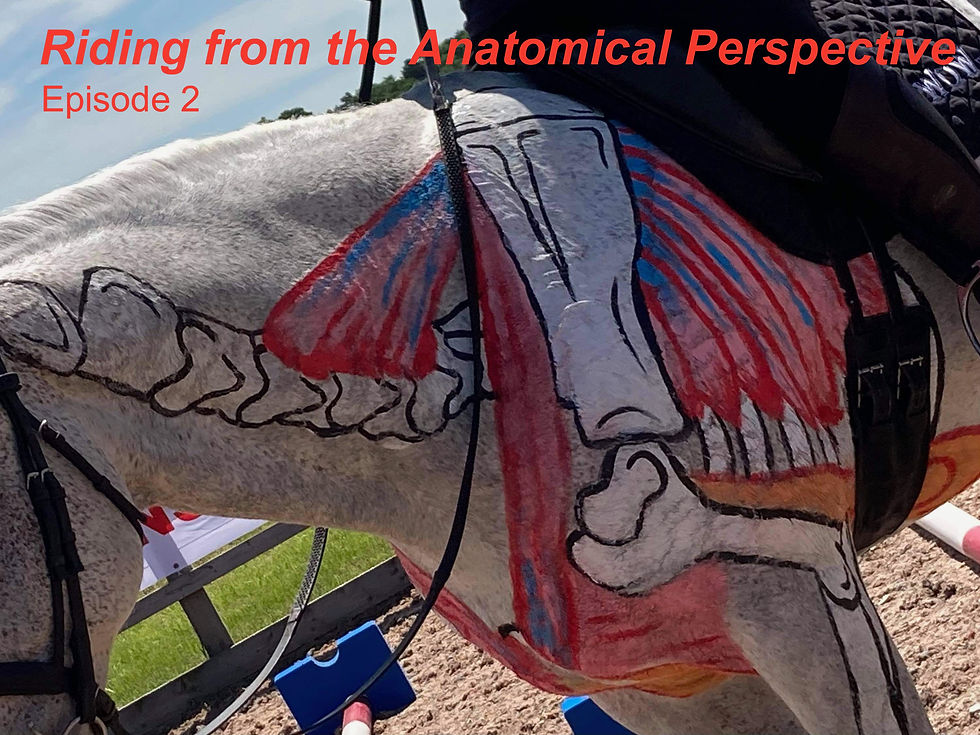Adding the Weight of A Rider
- Gillian Higgins

- Aug 30, 2021
- 3 min read
Updated: Jun 5, 2024
As soon as we sit on our horse's backs we compromise his posture and ability to move, affect his balance and increase the strain on his joints, tendons and ligaments. How depressing!
It's vital that we recognise this and how it happens before we can study how the horse supports his posture and musculoskeletal system. From there we can look at ways to strengthen his body in preparation for a rider and performance whatever the discipline.
Improving our equine partner's fitness, posture, strength and suppleness are key to preparing and future proofing the body. There are many ways we as rider's can help to reduce the burden we place on our horse's backs. Personal fitness, balance, posture and riding skill are all things we can work on to improve not only our own health but that of our horse's too.
In this blog article we will explore some of these methods and ideas and in episode 2 of the series of lecture demonstrations, Riding from the Anatomical Perspective
This jam-packed lecture demonstration will appeal to all riders whatever level or discipline and will help you improve your riding and ensure your horse is happy and healthy.
The first episode of this four-part series – an unridden demo covered in detail the basic anatomy of how the horse moves in walk, trot and canter and how his conformation can affect these gaits. In this second episode we build on that with the help of 3 different horses.
Event rider Fiona Davidson rides one of her young horses and with the help of painting the skeleton on one side and the muscles, the myofascial chains that affect the spine and hindlimbs on the other this whole subject is so much easier to understand.
Gillian's horse, Arty is also involved and he helps to illustrate the thoracic sling muscles.
This painting is from a different perspective so it’s accurate when you look at it from the side and the front.
This brings a whole new dimension to the vital role the thoracic sling muscles play.
Also, the newest member of the Horses Inside Out team, Toby makes his first appearance, helping to illustrate the role of the breathing muscles.
Good back posture
In this lecture demonstration we will cover in detail what is good back posture and what we as riders can do to help the horse support that back posture and prepare him for carrying the weight of the rider.
You’ll learn about the four main ways the horse maintains and supports good back posture:
Positioning of the head
The recruitment of muscles – which muscles need to be well toned
The thoracic sling muscles
Positioning of the hindleg
To apply everything that you learn to your own horse, a number of exercises will be demonstrated that are good for strengthening your horse’s body so he’s more able to perform as a ridden horse. These exercises are suitable for all horses whatever their age and are beneficial for keeping them healthy through their backs.

Influence of the rider
In this second episode, we move on to learn all about what happens to the horse when you add the weight of the rider. By the end of this two-hour online lecture demonstration, you will have the tools and understanding to ride in better harmony with your horse.
With the help of the three horses, you will get to see what happens when you add the weight of the rider and how it affects the horse’s posture, balance, general way of going and movement.
The role of tack
We also discuss the much debated topic of what happens when you add tack - the good and the bad. The rider’s position and balance and how that effects the horse in a positive and negative way. Also, we'll look at the timing of the leg aids and just how important it is to get this right and why.
This is sure to be a fascinating few hours.
The lecture costs just £20, or for all four in the series it’s £60.







Comments